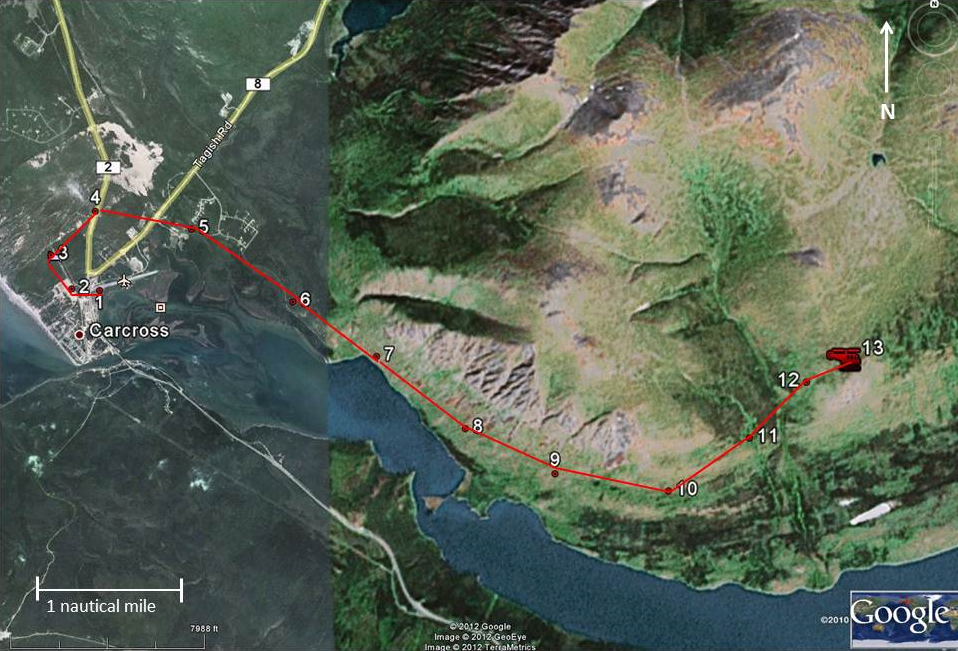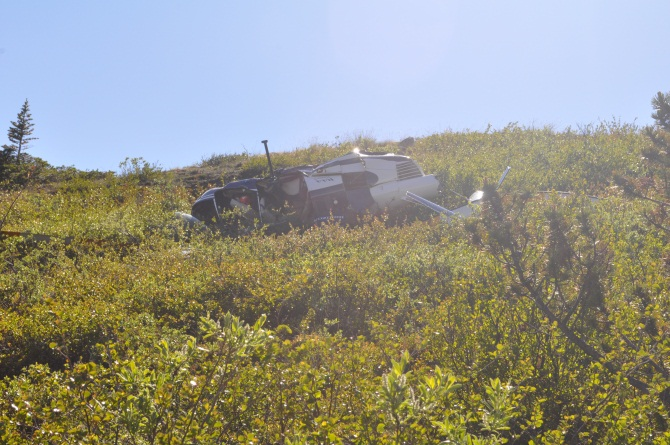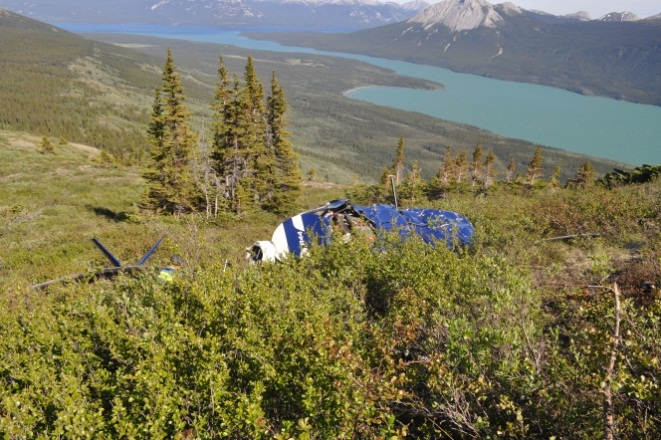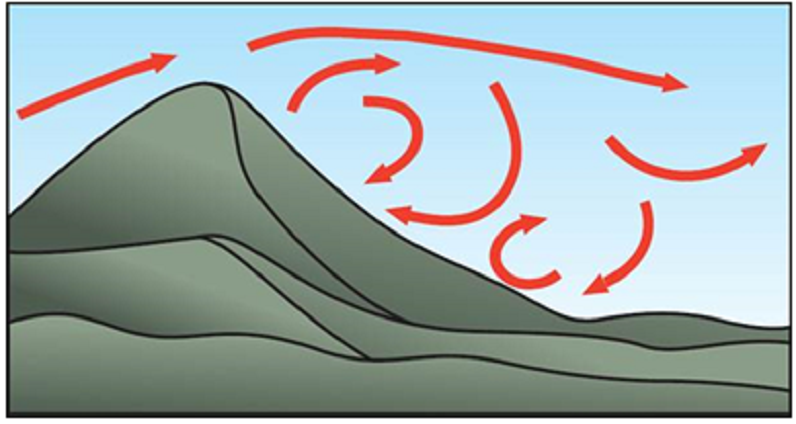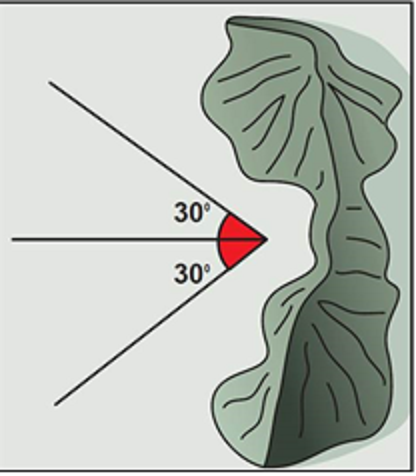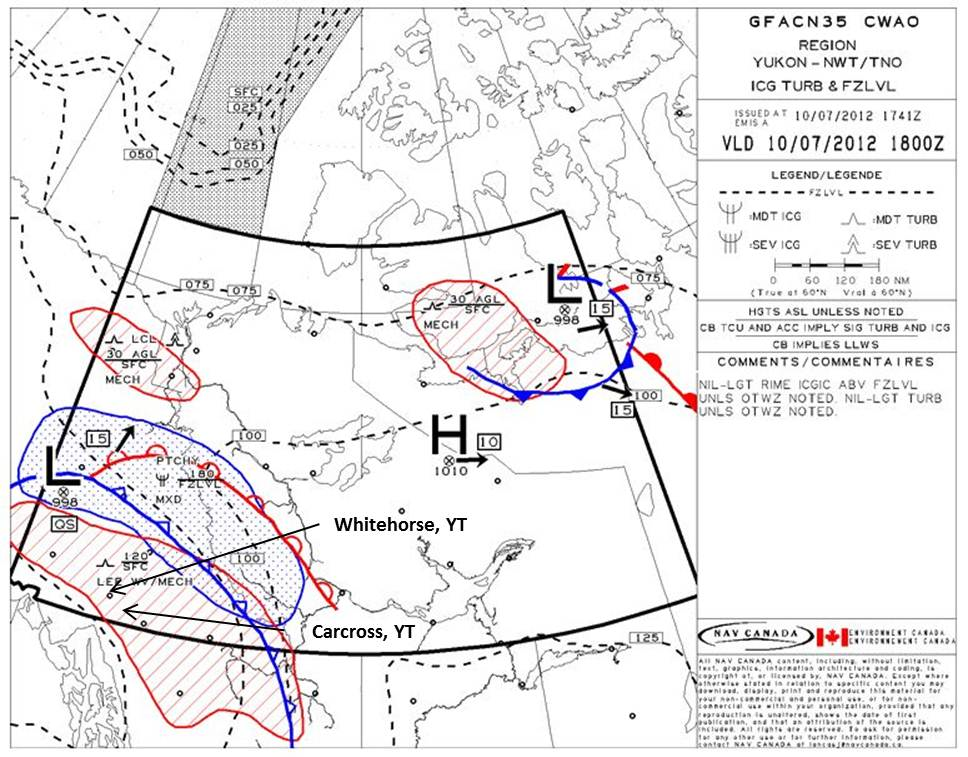Loss of control and collision with terrain
Horizon Helicopters Ltd.
Robinson Helicopter R44 II, C-GHZN
Carcross, Yukon, 5 nm E
The Transportation Safety Board of Canada (TSB) investigated this occurrence for the purpose of advancing transportation safety. It is not the function of the Board to assign fault or determine civil or criminal liability. This report is not created for use in the context of legal, disciplinary or other proceedings. See Ownership and use of content. Masculine pronouns and position titles may be used to signify all genders to comply with the Canadian Transportation Accident Investigation and Safety Board Act (S.C. 1989, c. 3).
Summary
At 0853 Pacific Daylight Time, a Horizon Helicopters Ltd. R44 II (registration C-GHZN, serial number 12252) departed Whitehorse, Yukon, on a wildlife survey flight. At approximately 1513, the Joint Rescue Coordination Centre received a 406-megahertz emergency locator transmitter signal from the aircraft. A company helicopter was dispatched to the site with emergency medical services personnel aboard. The wreckage was found approximately 5 nautical miles east of Carcross, Yukon, on Nares Mountain. The pilot was fatally injured, one passenger was seriously injured, and another received minor injuries. The passengers were treated and flown back to Whitehorse in the company helicopter that had been dispatched to the site. There was no post-impact fire.
Factual information
History of the flight
The day's flights originated from the Horizon Helicopters Ltd. (Horizon Helicopters) hangar located at the Whitehorse International Airport in Whitehorse, Yukon. The purpose of the flight was to transport 2 Yukon government surveyors to bear-bait sites in the Carcross, Yukon, area.
The flight departed at 0853 Footnote 1 and reached the first site at 0917, and visited another 9 sites in the region west of Carcross before stopping for fuel at 1148. At 1210, the helicopter departed the refuelling site, and proceeded to 9 more bait sites northwest and southwest of Carcross. Throughout the day, high winds prevented them from inspecting some sites at higher elevations. At 1442, the aircraft, registration C- GHZN, landed at Carcross and refuelled. Due to high winds, the pilot indicated that they would inspect as many of the outstanding sites as they could on the flight back to Whitehorse. The helicopter departed Carcross at 1501 for the final leg of the day, proceeding to a site east of Carcross. The flight followed the north shore of Tagish Lake and approached the wildlife survey site from the west. The pilot had been at this site numerous times in the past. The last GPS targetFootnote 2 was recorded at 1507 (Figure 1).
The investigation determined that the pilot overflew the site from the south and proceeded to turn 180° to the right. The helicopter then slowed to a hover, and began descending over the east side of the crest. Moments later, the helicopter experienced a gust of wind from the west, which caused it to drift to the left towards the eastern slope (lee side) of the crest. The helicopter then began an uncontrolled vertical descent. During this descent, the low rotor revolutions per minute (rpm) warning sounded and the main rotor tachometer dropped from 99% to 63%. The helicopter impacted the eastern side of the slope on the right-hand skid then rebounded down the slope before coming to rest nearly inverted on its left-side roof (Photo 1 and Photo 2).
The passenger in the left front seat sustained minor injuries, and was able to escape the wreckage, and then returned to the aircraft to assist with the evacuation of the rear passenger who had sustained severe injuries and was not able to extract himself from the aircraft. The left-front passenger also noted a strong fuel smell, and moved the more seriously injured passenger away from the aircraft, but, upon returning to retrieve the pilot, found the pilot to be deceased, and left him in place.
The pilot was secured to his seat by the 4-point harness and was not wearing a helmet. He had suffered blunt force trauma to his head and other areas, as well as asphyxial injuries.
Crash site
The wreckage left impact scars on the ground, indicating an upright impact on the sloping terrain.Footnote 3 The slope ran upwards to the right of the helicopter's right side. After impact, the fuselage bounced once and rolled to the left. The main fuselage came to rest at the same angle as the slope of the hill. The doors both appeared to have come off at impact. There was a transponder antenna, originally installed in the belly of the fuselage, embedded in the ground, indicating the exact place and attitude at impact. The right-side skid gear was broken off at the fuselage due to upward impact forces.
The tail boom had broken off just aft of the attachment junction. There were overload signs in both a downward direction and a final bending in an upward direction (with respect to the normal airframe orientation). This indicates a downward compression load at impact and an upward separation in tensile overload due to flailing and final resting position.
The main rotor had 1 blade showing indication of a ground strike at very low power. The blade had a very gradual bend from about mid-span to the tip, with leading-edge striation marks in the span-wise direction. The other main blade was bent in the opposite direction due to impact forces as the fuselage came to rest. The main rotor droop stops indicated heavy contact, although the main rotor mast was not bent to any large degree. One of the control rods was broken in a bending overload.
The tail rotor had no indication of rotation at the time of impact. One blade was nearly intact and the other was bent in a chord-wise direction. The tail rotor driveshaft and the driveshaft couplings showed no indication of significant rotation at the time of overload fracture. The vertical stabilizer showed an obvious compression impact.
All the seat structures bearing passengers, as well as the pilot's seat, had collapsed. The pilot seat compartment contained a satellite phone, and first aid and aircraft survival kits. The left-rear passenger seat held re-fuelling pumps, filters and hoses, which filled that baggage compartment. Filling the storage areas lessens the seat's ability to absorb vertical impact forces. Nothing was stored under the occupied passengers' seats during the flight.
The throttle was at maximum setting. Full flight control continuity could not be determined due to the impact forces crushing and jamming the linkages in the belly. The engine and drive train showed no anomalies that would indicate a loss of engine power to the rotors. The rotors are coupled directly to the engine and drive train through a belted system. If there is a large amount of drag on the rotors, then the engine will not be able to maintain rotor speed, and the rpm of the engine will decrease as the main rotor slows down.
Weather
Weather conditions at the time of the occurrence were suitable for visual flight rules (VFR) operations. Weather observations recorded at Carcross around the time of the occurrence showed surface wind from the south at 23 knots gusting to 31 knots. The low-level winds were forecast to be from the southwest at 30 knots. The Graphic Area Forecast (Appendix A) indicated that the region south of Whitehorse and in the vicinity of Carcross would experience moderate turbulence from the surface to 12 000 feet above sea level as well as lee-wave mechanical turbulence. Wind conditions at the accident site were strong at the time of the occurrence.
The Horizon Helicopters Ltd. Company Operations Manual (COM) provides cautionary information concerning low-level wind shear, and advises that the condition should be avoided. Neither the COM nor the manufacturer's flight manual identify a maximum wind limitation for flight operations, nor is it required by regulation.
Pilot
Records indicate that the pilot was certified and qualified for the flight in accordance with existing regulations. The pilot held a commercial pilot licence (helicopter), an airline transport pilot licence (aeroplanes) and was endorsed on 4 helicopter types. The pilot had accumulated approximately 15 000 total flight hours, of which 1100 were on helicopters. He had approximately 870 flight hours on the accident aircraft type. Records indicate that the pilot completed a mountain flying course in June 2009.
Aircraft
The occurrence aircraft was manufactured in 2008, and had been owned and operated by Horizon Helicopters since its import. It had accumulated a total of 1894.6 airframe hours at the time of the accident. The last maintenance action was carried out on 07 June 2012 at 1795.7 hours, and was a 50/100-hour engine inspection along with a 100/300-hour airframe inspection. Records indicate that the aircraft was certified, equipped, and maintained in accordance with existing regulations and approved procedures.
The investigation found that the helicopter was operating within all weight and balance limits as well as under all allowed and calculated altitude limits for hovering out of ground effect.
In October 1982, Robinson Helicopter issued Safety Notice (SN-10) - Fatal Accidents Caused By Low rpm Rotor Stall, revising it in in June 1994. They also issued SN-24 Low rpm Rotor Stall Can Be Fatal in September 1986, and revised it in June 1994. Both address low main-rotor speed and how to avoid it. SN-32 - High Winds or Turbulence issued in March 1998 also addresses that topic and advises pilots to “avoid flying on the downwind side of hills, ridges, or tall buildings where the turbulence will likely be most severe.”
The United States Federal Aviation Administration (FAA) also issued Special Airworthiness Information Bulletin ASW-95-01 (SAIB)regarding Robinson Helicopter model R22 and R44 main rotor/airframe contact accidents. That document has numerous recommendations, including the following:
Do not fly if any of the following conditions exist: surface winds (including gusts) exceeding 25 knots, surface wind gusts exceeding 15 knots, wind shear forecast or observed, and/or turbulence forecast or observed to be moderate, severe or extreme.
In response to the SAIB, Transport Canada issued Airworthiness Directive CF-96-08 on 30 April 1996. This mandated changes to the rotorcraft flight manual to include the cautions listed in the SAIB.
It was determined during the investigation that the main-rotor low-rpm horn had sounded briefly several times over the course of the day during approaches to several of the sites. This occurs when the main rotor rpm decreases to 96% to 97%.Footnote 4 Normal operating range for the R44 II main rotor is 101% to 102% under power.Footnote 5
The danger of low rotor rpm and blade stall is greatest in small helicopters with low blade inertia. It can occur in a number of ways, such as simply rolling the throttle the wrong way, pulling more collective pitch than power available, or when operating at a high-density altitude.
When rotor rpm drops, the blade pitch must be increased in order to maintain the same amount of lift. As the pitch increases, drag also increases, which then requires even more power to keep the blades turning at the same rotor rpm. When power is no longer sufficient to maintain rotor rpm and produce the required lift lift, the helicopter will descend. This changes the relative wind, and further increases the angle of attack of the main rotor blades. At some point, the blades will stall unless rotor rpm is restored. If the blades stall, total loss of lift will result. Footnote 6
Wind effects in mountain flying
NAV CANADA, in The Weather of the Yukon, Northwest Territories and Western Nunavut, describes lee effects:
When the winds blow against a steep cliff or over rugged terrain, gusty turbulent winds result. Eddies often form downwind of the hills, which create stationary zones of stronger and lighter winds. These zones of strong winds are predictable, and usually persist as long as the wind direction and stability of the air stream do not change. The lighter winds, which occur in areas called wind shadows, can vary in speed and direction, particularly downwind of higher hills. In the lee of the hills, the wind is usually gusty and the wind direction is often completely opposite to the wind blowing over the top of the hills. Smaller reverse eddies may also be encountered close to the hills.Footnote 7
Lee waves
The same document describes and illustrates lee wavesFootnote 8:
When air flows across a mountain or hill, it is disturbed the same way as water flowing over a rock. The air is initially displaced upwards across the mountain, dips sharply on the lee side, then rises and falls in a series of waves downstream. These waves are called mountain waves or lee waves and are most notable for their turbulence. They often develop on the lee side of the Rocky Mountains.
The Formation of Lee Waves
The development of lee waves requires that several conditions be met:
- the wind direction must be within 30 degrees of perpendicular to the mountain or hill. The greater the height of the mountain and the sharper the drop-off to the lee side, the more extensive are the induced oscillations.
- wind speed should exceed 15 knots for small hills and 30 knots for mountain ridges. A jet stream with its associated strong winds below the jet axis is an ideal situation.
- the wind direction should be constant while increasing in speed with height throughout the troposphere.
- the air is stable near the mountain peaks but less stable below. The unstable layer encourages the air to ascend and the stable layer encourages the development of a downstream wave pattern.
While all these conditions can be met at any time of the year, winter wind speeds are generally stronger, resulting in more dangerous lee waves.
The downdrafts associated with lee waves typically reach values of 2000 feet per minute, but downdrafts up to 5000 feet per minute have been reported. The strongest downdraft is usually found at a height near the top of the summit and can force an aircraft into the ground.
Horizon Helicopters' COM Section 4.8, Operations in Hazardous Conditions, refers to the Transport Canada Aeronautical Information Manual, section AIR 2.8, Low Level Wind Shear, which states in part:
Wind shear may create severe hazard for aircraft within 1000 ft AGL, particularly during the approach to landing and in the takeoff phases… the best defense against wind shear is to avoid it altogether.
Mountain-flying techniques
As previously described in the Transportation Safety Board's Aviation Investigation Report A09W0146, a light wind striking perpendicular to a ridge line will flow smoothly up-slope to the top of the ridge, and after passing the peak, the air will begin to descend, flowing down the lee slope. Turbulence is often associated with this transition zone. Pilots of aircraft flying on the downwind side of a ridgeline can expect higher engine power requirements to maintain altitude. In some cases, power requirements exceed available power. Attempts to maintain altitude by increasing rotor pitch can demand engine power beyond the aircraft's capability, resulting in a loss of rotor rpm.
Techniques have been developed to minimize the risks inherent in mountain flying operations. The first step is reconnaissance of the intended landing spot to determine site elevation, wind direction, power available, and approach path. The foremost consideration for the reconnaissance and landing approach is maintainance of a suitable drop-off,Footnote 9 which permits the pilot to fly away safely if conditions exceed safe handling and power requirements.
Industry-accepted procedures for razorback ridgeline operations usually involve figure-8 reconnaissance passes along the ridge at constant speed, which can be followed by an approach to overshoot that will confirm the suitability of the landing site and the approach path. The final approach to the landing zone is a gradually decelerating shallow descent slightly above and parallel to the ridge and into wind as much as possible. This allows for early loading of the rotor disc which stabilizes the approach, and aids in assessing power requirements and wind. The transition from effective translational lift Footnote 10 to ground effect Footnote 11 is accomplished while minimizing power changes to ensure that adequate power exists to carry out the landing safely. This avoids either a flare or coming to a stop while out of ground effect; both conditions can demand more power than the engine can supply to arrest an uncontrolled descent.
Analysis
There was no indication that an aircraft system malfunction contributed to this occurrence. As a result, the analysis will focus on the operational and environmental factors that contributed to the occurrence.
Conducting a reconnaissance pass is an industry standard and is taught at mountain flying schools. The pilot had completed a mountain flying course; however, for unknown reasons, he did not carry out a reconnaissance pass before attempting to land.
Downdrafts frequently exist on the lee side of mountain peaks and ridges. Those downdrafts can be severe, and may contribute to additional power demands during the approach for landing.
The pilot, upon entering the region downwind of the ridgeline, should have expected higher engine power requirements to maintain altitude in the descending air. Attempting to maintain altitude by increasing rotor pitch likely demanded engine power beyond the aircraft's capability, resulting in a loss of rotor rpm. In this helicopter, the rotors are coupled directly to the engine. When the increased pitch caused a low rotor speed condition, the engine did not have the power to overcome it and slowed down as well. The pilot attempted a landing where the power required exceeded the power available.
Numerous warnings from both the helicopter manufacturer and the FAA have indicated the dangers of flying this model in high-wind conditions, and that it may require power that is beyond the limits of the aircraft and power plant.
The pilot was not wearing his flight helmet, which contributed to his head injuries. Despite the recognized benefits of head protection, there is no regulatory requirement for helicopter pilots to wear helmets. If helicopter pilots do not wear helmets, they are at increased risk of incapacitation, serious injuries or death in the event of an accident.
Findings
Findings as to causes and contributing factors
- A reconnaissance pass was not carried out prior to the landing attempt. As a result, the pilot was unaware of the intensity of the down-flowing air near the intended landing area.
- While conducting the approach to land in these downdraft conditions, insufficient power was available to maintain rotor rpm, and a rate of descent developed from which recovery was not possible.
- The pilot was not wearing his flight helmet, which contributed to the severity of his head injuries.
Findings as to risk
- If helicopter pilots do not wear helmets, they are at increased risk of incapacitation, serious injuries or death in the event of an accident.
Safety action
Safety action taken
The operator has implemented a safety policy that requires that all pilots wear flight helmets during flight operations.
This report concludes the Transportation Safety Board's investigation into this occurrence. Consequently, the Board authorized the release of this report on . It was officially released on .
